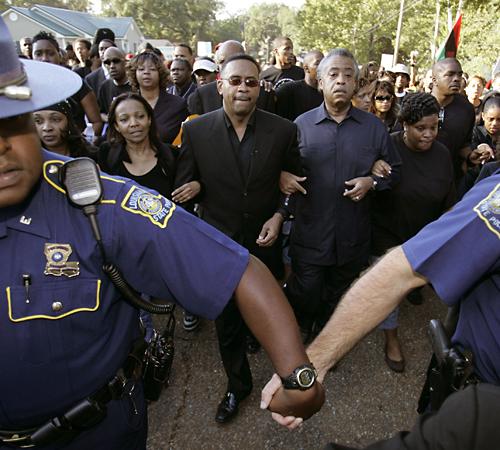Advocates gather to back ‘Jena Six’

Radio personality Michael Baisden, second from left, with Rev. Al Sharpton, and Melissa Bell, mother of Mychal Bell – one of the black students who is currently serving time in a a Louisiana state prison – walk behind two Louisiana State Troopers during a THE ASSOCIATED PRESS, ALEX BRANDON
September 21, 2007
JENA, La. – Drawn by a case tinged with one of the most hated symbols of Old South racism – a hangman’s noose tied in an oak tree – tens of thousands of protesters rallied Thursday against what they see as a double standard of prosecution for blacks and whites.
The plight of the so-called Jena Six, a group of black teens initially charged with attempted murder in the beating of a white classmate, became a flashpoint for one the biggest civil-rights demonstrations in years.
Old-guard lions like the Revs. Jesse Jackson and Al Sharpton joined scores of college students bused in from across the nation who said they wanted to make a stand for racial equality just as their parents did in the 1950s and ’60s.
“It’s not just about Jena, but about inequalities and disparities around the country,” said Stephanie Brown, 26, national youth director for the NAACP, who estimated about 2,000 college students were among the throngs of mostly black protesters who overwhelmed this tiny central Louisiana town.
But the teens’ case galvanized demonstrators as few legal cases have in recent years.
Get The Daily Illini in your inbox!
The cause of Thursday’s demonstrations dates to August 2006, when a black Jena High School student asked at a student assembly whether blacks could sit under a shade tree that was a frequent gathering place for whites. He was told yes. But nooses appeared in the tree the next day. Three white students were suspended but not criminally prosecuted. LaSalle Parish District Attorney Reed Walters said this week he could find no state law covering the act.
Brown said the Jena case resonates with the college-aged crowd because they aren’t much older than the six youths charged. Many of the student protesters had been sharing information about the case through Facebook, MySpace and other social-networking Web sites.
Jackson, who led a throng of people three blocks long to the courthouse with an American flag resting on his shoulder, likened the demonstration to the marches on Selma and the Montgomery bus boycott. But even he was not entirely sure why Jena became the focal point.
“You can never quite tell,” he said. “Rosa Parks was not the first to sit in the front of the bus. But the sparks hit a dry field.”
The noose incident was followed by fights between blacks and whites, culminating in December’s attack on white student Justin Barker, who was knocked unconscious. According to court testimony, his face was swollen and bloodied, but he was able to attend a school function that same night.
Six black teens were arrested. Five were originally charged with attempted second-degree murder – charges that have since been reduced for four of them. The sixth was booked as a juvenile on sealed charges.
Martin Luther King III, son of the slain civil rights leader, said punishment of some sort may be in order for the six defendants, but “the justice system isn’t applied the same to all crimes and all people.”
People began massing for the demonstrations before dawn Thursday, jamming the two-lane highway leading into town and parking wherever they could. State police estimated the crowd at 15,000 to 20,000. Organizers said they believe it drew as many as 50,000.
Demonstrators gathered at the local courthouse, a park, and the yard at Jena High where the tree once stood (it was cut down in July). At times the town resembled a giant festival, with people setting up tables of food and drink and some dancing while a man beat on a drum.
Sharpton admonished the crowd to remain peaceful, and there were no reports of trouble. State police could be seen chatting amicably with demonstrators at the courthouse.
In Washington, the chairman of the House Judiciary Committee said he would hold hearings on the case, though he did not set a date or say if the prosecutor would be called to testify.
Walters, the district attorney, has usually declined to discuss the case publicly. But on the eve of the demonstrations, he denied the charges against the teens were race-related and lamented that the victim of the beating has been reduced to “a footnote.”
Associated Press writers Errin Haines in Atlanta and Michael Kunzelman in Jena contributed to this story.






